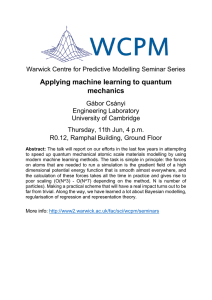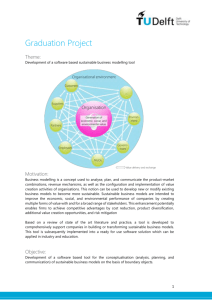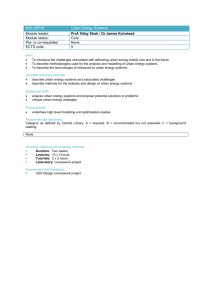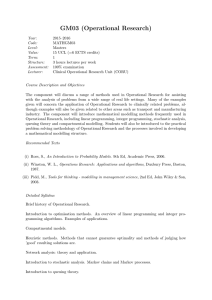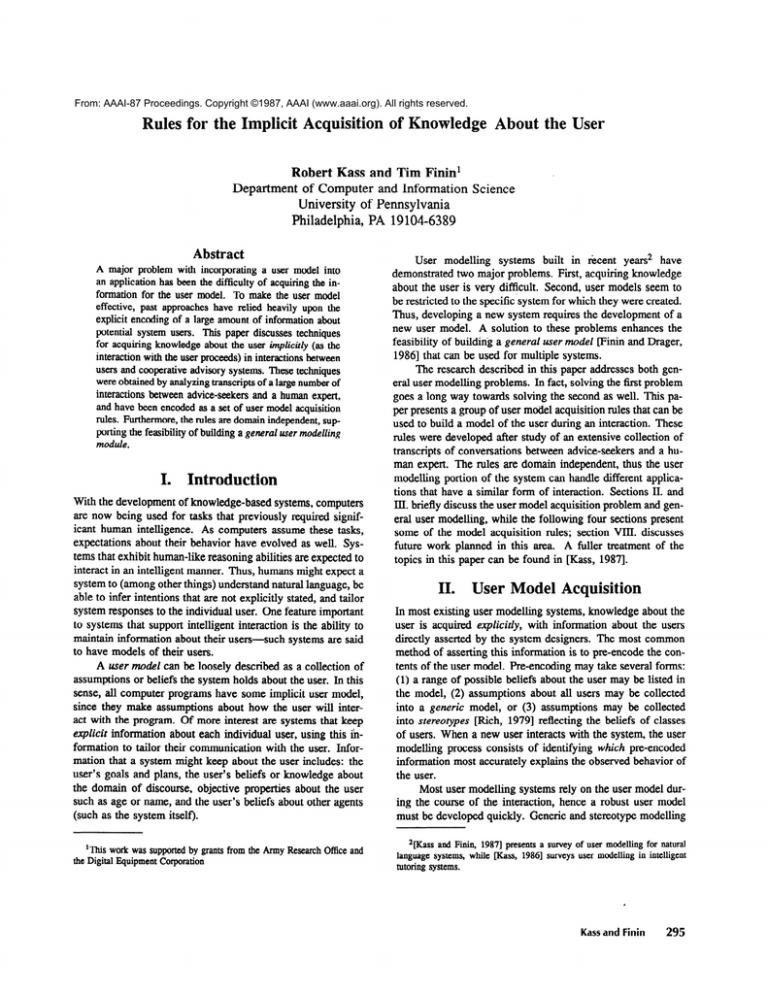
From: AAAI-87 Proceedings. Copyright ©1987, AAAI (www.aaai.org). All rights reserved.
Rules for the Implicit Acquisition of Knowledge About the User
Robert Kass and Tim Finin
Department of Computer and Information Science
University of Pennsylvania
Philadelphia, PA 191046389
Abstract
A major problem with incorporating a user model into
an application has been the difficulty of acquiring the information for the user model. To make the user model
effective, past approaches have relied heavily upon the
explicit encoding of a large amount of information about
potential system users. This paper discusses techniques
for acquiring knowledge about the user implicirly (as the
interaction with the user proceeds) in interactions between
users and cooperative advisory systems. These techniques
were obtained by analyzing transcripts of a large number of
interactions between advice-seekers and a human expert,
and have been encoded as a set of user model acquisition
rules. Furthermore, the rules are domain independent, supporting the feasibility of building a general user modelling
module.
I.
Introduction
With the development of knowledge-based systems, computers
are now being used for tasks that previously required significant human intelligence. As computers assume these tasks,
expectations about their behavior have evolved as well. Systems that exhibit human-like reasoning abilities are expected to
interact in an intelligent manner. Thus, humans might expect a
system to (among other things) understand natural language, be
able to infer intentions that are not explicitly stated, and tailor
system responses to the individual user. One feature important
to systems that support intelligent interaction is the ability to
maintain information about their users-such systems are said
to have models of their users.
A uSer model can be loosely described as a collection of
assumptions or beliefs the system holds about the user. In this
sense, all computer programs have some implicit user model,
since they make assumptions about how the user will interact with the program. Of more interest are systems that keep
explicit information about each individual user, using this i&
formation to tailor their communication with the user. Information that a system might keep about the user includes: the
user’s goals and plans, the user’s beliefs or knowledge about
the domain of discourse, objective properties about the user
such as age or name, and the user’s beliefs about other agents
(such as the system itself).
‘This work was supported by grants from the
the Digital Equipment Corporation
Research Office and
User modelling
systems built in &cent years2 have
demonstrated two major problems. First, acquiring knowledge
about the user is very difficult. Second, user models seem to
be restricted to the specific system for which they were created.
Thus, developing a new system requires the development of a
new user model. A solution to these problems enhances the
feasibility of building a general user model [Finin and Drager,
19861 that can be used for multiple systems.
The research described in this paper addresses both general user modelling problems. In fact, solving the first problem
goes a long way towards solving the second as well. This paper presents a group of user model acquisition rules that can be
used to build a model of the user during an interaction. These
rules were developed after study of an extensive collection of
transcripts of conversations between advice-seekers and a human expert. The rules are domain independent, thus the user
modelling portion of the system can handle different applications that have a similar form of interaction. Sections II. and
III. briefly discuss the user model acquisition problem and general user modelling, while the following four sections present
some of the model acquisition rules; section VIII. discusses
future work planned in this area. A fuller treatment of the
topics in this paper can be found in [Kass, 19871.
II.
User Model Acquisition
In most existing user modelling systems, knowledge about the
user is acquired explicitly, with information about the users
directly asserted by the system designers. The most common
method of asserting this information is to pie-encode the contents of the user model. Pre-encoding may take several forms:
(1) a range of possible beliefs about the user may be listed in
the model, (2) assumptions about all users may be collected
into a generic model, or (3) assumptions may be collected
into stereotypes [Rich, 19791 reflecting the beliefs of classes
of users. When a new user interacts with the system, the user
modelling process consists of identifying which pre-encoded
information most accurately explains the observed behavior of
the user.
Most user modelling systems rely on the user model during the course of the interaction, hence a robust user model
must be developed quickly. Generic and stereotype modelling
2Kass and Finin, 19871 presents a survey of user modelling for natural
language systems, while Bass, 19861 surveys user modelling in intelligent
tutoring systems.
Kass and Finin
295
approaches are particularly attractive because they can rapidly
develop a large set of beliefs about a particular user. A generic
modei provides an initial set of assumptions about the user,
while a stereotype approach will also provide a large set of
beliefs once a stereotype (or several stereows) is triggered.
Unfortunately, the amount of information that k&t be
explicitly pre-&coded can be prohibitive. In fact, for many
systems, building the user model can be much more time consuming than building the domain knowledge base, making the
implementation of a user modelling system very unattractive.
Furthermore, specific user models must be built for each apnliratinn
yrrvubr”lA.
The user model acquisition techniques discussed in this
paper take a different approach to acquiring the user model.
These techniques build the user model implicitly-as the system
C”A.I
interaotc
ll.C”lLIVL”
with
..LUI
the
lrll”
IICPIUUVI.
1mn1;r;t
LIIAyLIwIL
l,PPP
mnrlnl
uobd,1. III"UbI
a.-n..~aX#w3
ak.yul~lu"ll
minimizes (or even eliminates) the need for explicit coding of
user model information. Thus, effective implicit user model
acquisition can greatly reduce the development effort required
to implement a user modelling system.
Implicit user model acquisition techniques have not been
used extensively in the past because they have not performed
weii. It has been generally believed that the content of the
communication between user and system is too limited to
quickly build a robust model of a new user. The goal of
this paper is to show that implicit acquisition techniques can
. ...
---: -,-,-. pruau~t;
---Leq- d.- --l_.-+
---de* T. 3.‘.
r*
yuuuy
roousr moael.
ffl aomg so, me acquisiuon
rules rely. on certain features of human behavior, using information obtained from user and system behavior (as well as the
domain model of the underlying application and the current
model of the user) as clues to infer more general information
about the beliefs and knowledge of the user. In fact, the rules
are capable of producing a model that can support a substantial portion of the behavior of the expert participant in the
transcripts studied.
There are three senses of generality that apply to user modellinsx, 1Jser
mav
he
peneral
-L_-- models
--------L
----,
-- c)
------
w;th
~gttect
lc-v’
tn
-- the
-a- .mnw
-.“o-
of users they can handle. Most user modelling systems have
this form of generality. User models may also be general
with respect to the form of interaction with the user. Such a
user model could effectively deal with interactions that might
include menus, graphics, or natural language. Finally, user
models may be general with respect to the domain of the interw.tinn
LLYbA”I..
1Aa rl~.m~;n-e~eww-~l
u”IIAcLIII-~~11~~c.u
,,QP,.
UUcll
mfirlnl
IfiI”\+UI
on..lrl
La”ULLL
hn
“b
..~.a,4
l.bJbAa L.
111 ex:,cl+am~.
DJ JLbAlIJ
covering a diverse range of applications.
Completely general user modelling allows the user modelling portion of the system to be an independent module
that
*.1..*
rnllertc
-vYII..Y
and
. ..I..
maintainc
*.l-...-1I”
infnrmatinn
LI.L”IA..CICI”a.
nhnllt
UVVYC
the
Cll”
IIPPVE
UYYL”,
ad
UllU
communicates with other modules in the system via a welldefined interface. Such a user modelling module would use
four sources of information for making inferences about the
user: the behavior of the user observed by the system, the behavior of the system observable by the user, the domain knowledge of the underlying application, and the current model of
296
Cognitive Modeling
Figure 1: User modelling module sources of information
the user. The organization of a system incorporating a user
modelling module is illustrated in figure 1.
-----.-4
T”niS Parr -will fOC-~SOfi User mQdeii~ig that is genercu
with respect to the domain. (User generality is assumed to
be a requirement of any user modelling system.) There are
two reasons for this limitation. First, there is an existing trend
.,.,,“..Ac.
LUWcllUJ
c..:1,4:..,
UUllUlll~
A,...“...:..b
:“..4be..w.Ad..,
uulIlulll-llIuqJGIIuGllL
nw,n,nmn
JJJLGlIW,
“..#.h
m.lbII
.xX. ‘% “..a..+
aa wqJGlL
system shells. An expert system shell provides the reasoning
and control structures for a system, and is capable of reasoning
with knowledge bases from a variety of domains. A domainindependent user modelling module can thus be used in conjunction with other domain-independent modules to enhance
the capabilities of such systems.
The second reason for focusing on domain generality is
that building user models that are general with respect to the
form of interaction is very difficult. Many of the implicit
acquisition rules assume particular interaction characteristics.
Shifting the form of interaction can affect not only these assumptions, but even the methods used to access the interaction
between user and system. (Consider the difference between
natural language interaction and interaction using graphics and
a mouse.) Restricting the foorm of interaction thus constrains
the model acquisition problem, enabling useful assumptions
about the behavior of user and system.
In this work, the form of interaction is limited to cooperative advisory systems. A cooperative advisory system has a
,...L”h.-r+:nl
Juuz9uLllLLa.l
Lr.A,.
uuuy
s.cl-.....l.T.A#vd
v1 NlUWlcuLjC
#al..-..+
n ~nv+:n..lor
auuuraycul.lmmI.l
AAm”:e
. . . . ..ec.
uuuuull,u3111Lj
this knowledge to give advice to users. Since it is cooperative,
the system will try to anticipate the user’s needs and goals, tailoring its interaction to be as helpfL1 as possible. Although not
rpnllirement
nf Yvvyvluu.”
rnnnrvative
aAvicnrv
alcn
u9 *~LLY”I..“I.L
“1
uu.
‘““‘J cvctemc
“J YC”.‘““, thic
CI.L”wnrk
I. v--L UYV
assumes that the user and system communicate with each other
through a natural language interface. The knowledge of the
advisory system consists of factual knowiedge about concepts
and things in the world, and the reasoning rules it uses to give
advice. The information to be modelled is primarily long term,
such as the user’s knowledge about the domain that tends to
Figure 2: ML-ONE representationof conceptsderived from “I have $40,000 in moneymarket”
persist over many interactions.
The rules presentedin this paper have been developedby analyzing interactions between human experts and their clients.
The data examined includes transcripts of approximately 100
interactions from a radio talk show entitled “Harry Gross:
Speaking about Your Money.“3 The examples used in this
paper are taken from these transcripts. These conversations
are appropriate for analysis since they represent a situation
similar to what might occur in a cooperativeadvisory system:
the form of interaction is quite limited (the participants communicate via telephone),the callers vary in their knowledge
of the domain, and the expert has no pre-definedmodel of the
caller.
The user model acquisition rules in the following sections should be consideredto be reasonabb rules-they are
not absolute. Exceptions (which are sometimesquite easy to
find) exist for each rule. This does not detract from the effectiveness of the rules, since the acquisition rules are intended
to draw conclusions a human would reasonablymake. Sometimes theseconclusionswill be over-riddenas new information
arrives; sometimesthe rules will draw conclusionsthat are not
correct-humans have the same problem. It might be convenient to think of the acquisition rules as default rules [Reiter, 19801,but other approaches,such as evidential reasoning
methods,could be used as well.
The rules can be loosely partitioned into three categories:
communicativerules, model-basedrules, and human behavior
rules. Communicative rules focus on the communication between the system and the user. Model-basedrules dependon
certain relationships in the structure of information between
the domain model and the current model of the user. Human
behavior rules dependon featuresof human behavior that are
3Thetranscripts
weremade by Martha Pollack and Julia Hirschbergfrom
shows originally broadcaston station WCAU in PhiladelphiabetweenFebruary 1 and February 5, 1982.
typical or in some senseuniversal. The following sectionslook
at these classesof rules, and discussseveralrules in detail. A
complete description of all of the rules can be found in [Rass,
19871.
.
es
The communicativerules are triggered by statementsmade by
the user or the system, deriving information about the user
basedon the conventionsgoverningnormal discoursebetween
cooperativeagents. The class of communicative rules can be
further divided into direct inference rules and inzplicature rules.
Direct inference rules are concernedsolely with the information contained in a statement. When the user makes a
statement,the user modelling module can assumethe user believes that statement.This can result in a number of assertions
to the user model concerningthe user’s beliefs about the concepts and attributes mentionedin the statement.For example,
the statement“I have $40,000in money market”could produce
the following output from the parser:
3x1
(investment A
3z2(investor(xl, x2) A x2 = user) A
3X3(instrument(xl,x3) A moneymarlret(xs))A
Zix4(amount(xl,x4) A dollar(x4) A x4 = 40,00@)
This, in turn, can be decomposedto produce 15 simple assertions used to generatethe concept and role definitions for a
I&ONE knowledge base depicted in figure 2.4 Furthermore,
statementsmay have presuppositions,which the user must believe as well. Kaplan [Kaplan, 19821and Kobsa wobsa, 19841
have presentedmethods for computing these presuppositions,
which may be assertedto the user model,
The implicature rules are inspired by Grice’s maxims for
cooperative communication @rice, 19751. The assumption
4These steps have been implementedin a Prolog program that takes a
first-orderlogic representationof a statementand builds a NIKL (New Implementationof KLONE) Moser, 19831knowledgebase.
Kass and Finin
297
that the user is striving to be cooperative provides the system
with certain expectations about user behavior. These expectations can be exploited to draw inferences about what the user
does and does not know. The remainder of this section presents
three rules inspired by the maxims of relation, quantity, and
manner; illustrating them with examples from the transcripts.
Relevancy Rule
Grice’s maxim of relation tells a speaker to make the
contents of an utterance relevant. Assuming the user obeys
this maxim, the user mo&lling module can assume what the
user says is relevant. The rule can be stated as follows:
Rule 1 If the user says P, the user modelling module can assume that the user believes that P, in its entirety, is used in
reasoning about the current goal or goals of the interaction.
In addition to claiming that the user believes what is said
is relevant, the relevancy rule states that the user believes that
everything in the statement is relevant. This can be illustrated
with an example (the client’s statements am preceded by a “C”
and the expert’s by an “E”).
C. I just retired December first, and in addition to my pension and social security I have a supplemental annuity
which I contributed to while I was employed from the
state of New Jersey mutual fund. I’m entitled to a lump
sum settlement which would be between $16,800 and
$17,800, or a lesser life annuity and the choices of the
annuity would be $125.45 per month. That would be the
maximum with no beneficiaries.
E. You can stop right there, take your money.
In this example the caller believes a large amount of information is required to answer her question, thus she proceeds to
talk about her recent retirement and source of income. The
expert recognizes that the only information relevant in determining how she should take her supplemental annuity is the
value of the annuity if taken as a lump sum versus the monthly
payments that could be received. Once the expert has this information (and has identified the caller’s goal) he interrupts
and provides the answer. Meanwhile, in modelling the caller,
the expert can conclude that she has little knowledge of the
reasoning involved in making the decision. She feels that all
the information she has listed is important to the reasoning
process, while in fact it is not. Thus the relevancy rule can be
used to acquire information about incorrect reasoning a user
may perform.
Sufficiency Rule
The sufficiency rule is inspired by the maxim of quantity.
The system can reason as follows: if the user were complete’iy
knowledgeable about the domain, he would provide information sufficient for the system to satisfy the user’s goal. Suppose
what the user says turns out to be insufficient? In this case
the user must lack some knowledge that the system has. A
user may have three types of knowledge about entities in the
domain knowledge base: knowledge of an entity, knowledge
of the relevance of an entity, and knowledge of the value of
an entity. When the user is cooperative, yet omits a piece of
298
Cognitive Modeling
information that the system knows is relevant, it is due to a
lack of knowledge of one of these three types.
The sufficiency rule says:
Wulle 2 If the user omits a relevant piece of information from
a statement, then either the user does not know of that piece of
information, does not know whether that information is relevant
to his current goal or goals, or does not know the value for the
piece of information.
Once again an example will illustrate this rule.
C. I’ve got $2250 to invest right now in an 18 month certificate and I don’t know whether to go the variable rate
or the fixed rate now or the fixed rate later.
E. Have you any money invested now?
C. Yes, I do.
E. In what?
C. I’ve got $5000 in a money market fund.
E. Have you anything in certificates or anything else?
C. I’ve got three stocks.
E, Three separate stocks?
C. Yes sir.
In this conversation, the caller believes his initial statement
of the problem is sufficient for the expert to make a decision.
Instead, the expert realizes a lot more information about the
caller’s investments are needed. The expert proceeds to ask
questions to obtain this information. Even then, the caller
provides minimal answers because he does not know what
additional information is relevant until the expert specifically
asks for it. In this case it seems obvious that the user knows the
additional information, he just does not realize it is relevant.
In using the sufficiency rule, the user modelling module
must be able to “turn around” the reasoning rules in the domain
model, in order to identify properties that are relevant. This
collection of relevant properties creates an expectation of the
information the user should provide. Information in the set of
expectations that is not provided thus must be information the
user lacks knowledge of.
The sufficiency rule might be strengthened further. If the
user is being fully cooperative he will try to be as helpful as
possible. Suppose the user knows a piece of information, but
does not know its value. Por example, the user might know
that the due date of a money market certificate is relevant
information, but not know the actual due date. A truly cooperative user would tell the system that he does not know the
due date. Thus the sufficiency rule might be limited to conclude that either the user does not know of the information,
or does not know that it is relevant. Furthermore, if the user
does not know of the information, he certainly cannot believe
it is relevant, so the sufficiency rule could make a definite
conclusion in this case.
Although the strengthened sufficiency rule seems attractive, that level of cooperation by the user does not seem likely.
People are reluctant to display their ignorance. Thus, when
they don’t know something, they avoid mentioning it, even
when they believe it is relevant.
Rule 7 If the user is the agent of an action, then the user modelling module can attribute to the user knowledge about the
action, the substeps of the action, and the factual information
related to the action.
For example, if the user says “I just rolled over two
CD’s,” the user modelling module can recognize that the user
is the agent of the “roll over” action. The agent rule will
thus conclude that the user knows about the steps involved in
rolling over a CD. Furthermore, the agent rule will also assert
that the user knows about related facts, such as: that CD’s
have a due date, that money from a CD can be reinvested, that
CD’s are obtained from banks, and so on. Thus the agent rule
can be particularly powerful in contributing information about
the user.
Evaluation Rule
The evaluation rule uses the domain model’s reasoning
knowledge to make conclusions about the reasoning knowledge the user has. Many times in advisory interactions the
expert must evaluate beliefs held by the user or actions performed by the user in light of the extensive knowledge the
expert has. If the expert’s evaluation differs from that of the
user, this indicates that the user does not know some of the
reasoning that the expert used. The rule is stated as follows:
Rule 8 If the system is able to evaluate actions taken by the
user given a certain situation, and those actions do not conform to the actions the system would have taken, then the user
modelling module can identijlj, portions of the reasoning done
by the system that the user does not know about.
An example of the use of the evaluation rule can be seen
in the following conversation.
C. I have $10,000 in stocks and $10,000 in a savings fund
E. Why so much in a savings account?
In this conversation the caller makes a statement that leads the
expert to an immediate evaluation: she has too much money’in
her savings account. ’ Thus, in modelling the caller, the expert
can conclude that she does not recognize the reasoning that
implies that a lot of money in a savings account will result in
a relatively low return.
VPIL
@onclusion
The long term goal of this research is the development of a
general user modelling system that can act as a repository of
knowledge about individual users, and service the needs of a
number of applications. The primary obstacle to this goal is the
difficulty of explicitly acquiring and building the user models,
motivating the development of a set of rules (currently 18,8 of
which are discussed in this paper) that can be used to acquire
knowledge about the user implicitly from his interaction with
the system.
5Theseconversationswere transcribedin February, 1982, when the U.S.
inflation rate was near its peak. At that time the interest rate on a savings
account was considerablyless than what could be earnedin a money market
fund, so having a lot of money in a savingsaccountwas always a bad idea.
300
Cognitive Modeling
The next step is to implement the model acquisition rules
in a user modelling system to test their effectiveness. This
implementation will comprise one portion of a general user
modelling module. This module will assume that the user
communicates with the underlying application via a natural
language interface, having access to the output of a parser
encoded in a meaning representation language (MRL). An underlying domain model for investment securities has been built
and will be used to test the acquisition rules. This model uses
the KL-ONE-like language NlKL Moser, 19831, and currently
consists of over 150 concepts.
There are a number of issues not discussed in this paper
that will be addressed in the implementation. These issues
include the use of a truth maintenance system to manage the
non-monotonic nature of user modelling, and the development
of rules to arbitrate between the acquisition rules when they
conflict regarding the user’s knowledge of a particular item. A
more complete description of current research and future plans
can be found in [Kass, 19871.
pinin and Drager, 19861 T. Finin and D. Drager. GUM&:
a general user modelling system. In Proceedings of the
1986 Conference of the Canadian Society for Computational Studies of Intelligence, pages 24-30, 1986.
[G&e, 19751 H. P. Grice. Logic and conversation.
In P. Cole and J. L. Morgan, editors, Syntax and Semantics, Academic Press, New York, 1975.
[Kaplan, 19821 S. J. Kaplan. Cooperative responses from a
portable natural language database query system. Artijcial Intelligence, 19(2): 165-188, 1982.
[Kass, 19861 R. Kass. The Role of User Modelling in Intelligent Tutoring Systems. Technical Report MS-CIS-86-58
(Lint Lab 41), Department of Computer and Information
Science, University of Pennsylvania, 1986.
[Kass, 19871 Id. Kass. Implicit Acquisition of User Models
in Cooperative Advisory Systems. Technical Report MSCIS-87-05, Department of Computer and Information
Science, University of Pennsylvania, 1987.
[Kass and Finin, 19871 R. Kass and T. Finin. Modelling the
user in natural language systems. Computational Linguistics, Special Issue on User Modelling, 1987.
[Kobsa, 19841 A. Kobsa. Three steps in constructing mutual
belief models from user assertions. In Proceedings of
the 6th European Conference on Artificial Intelligence,
pages 423-427, 1984.
maser, 19831 M. G. Moser. An Overview of NIKL, The
New Implementation of KL-ONE. Technical Report 542 1,
Bolt, Beranek and Newman, 1983.
[Reiter, 19801 R. Reiter. A logic for default reasoning. Artijscial Intelligence, 13(1):81-132, 1980.
@Xich, 19791 E. Rich. User modelling via stereotypes. Cognitive Science, 3~329-354, 1979.

